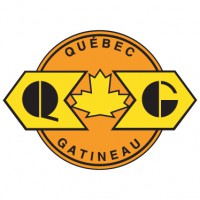
My name is Bernard Hellen and I model the G&W Quebec Gatineau shortline railroad from Montreal to Quebec City. These are my adventures in the hobby…
FU 2020. Good riddance. HAPPY NEW YEAR 2021.
Every year for the past 7 years, I’ve occasionally blogged on my model railroad hobby (addiction?). Part of that is sharing some thoughts and setting embarrassing unrealistic new years resolutions. Hey, it’s what I do at this time of the year….time to reflect on the past and plan for the future.

Most times when I look back on my thoughts from the previous year, I am a little dismayed at how little I’ve accomplished. Occasionally I will celebrate the completion of a goal. But WOW did 2020 ever throw me for a loop. I first talked about COVID on March 14th, with the post Covid-19 and the model railroading hobby and predicted (unfortunately) a number of things that have ultimately come true. On the positive side, the model railroad hobby is flourishing and Joe Fugate of MRH has noted that the hobby is booming with MRH mag setting all time records with total unique audience web hits in the upper 90,000s per month.

Looking back at my post on January 6th, 2020 entitled, 20 Model Railroad Resolutions for 2020, I am reminded just how much the world has changed in the past year. My goals of doing more with friends, getting into operations (with friends), establishing a local group of rotating OPs sessions, as well as attending a Convention, all seem very unattainable right now. On the positive side, my goal to STOP going to Train Shows came true (ok, funny, not funny).

The BIG surprise for the year was that I became a model railroad manufacturer. Honestly didn’t see that one coming! Who could’ve predicted that my 3D printed https://miniprints.ca/ would become a thing. Last year, miniprints did over 500 orders to amazing modellers in over a dozen countries all over the world including Australia, Canada, France, Germany, Italy, New Zealand, Norway, The Netherlands, United Kingdom and the United States.
While I didn’t get downstairs to work on my railroad at all this year, my creative itch has been scratched when designing miniprints for others. THE MOST fulfilling part of modelling in 2020 has been seeing what all my customers have done with their miniprints. I love getting and posting pics on the miniprints facebook page (1544 followers and growing!!!!!!) of all of the fabulous modelling being done. Other firsts in 2020 included, writing my first published article and conducting my first ever online clinic. Also like every year, continued to meet some amazing new people and make some great new friends (albeit, virtually).

So in balance, 2020 was a year none of us will soon forget. There was the good, the bad, and the unexpected. Now there’s one question left… dare I even attempt to make any new year’s resolutions for 2021?
How to paint 3D resin miniprints online clinic

As part of the excellent NMRAx GatewayX convention on Thursday, July 16th, I presented an online clinic on the steps I use to realistically paint my miniprints 3d printed miniatures to make my model railroad come alive.
It was my first time ever presenting a clinic and it was a lot of fun. The one-hour clinic was streamed live on Facebook and YouTube. A number of people who missed the live stream asked if the clinic could be re-posted – so here it is. The miniprints clinic portion starts at 1:58:27 in the stream:
These are the steps that work for me and I’m sure that there are many other techniques that you can apply to bring your resin 3d prints to life. Do you have a technique that works for you? Are you proud of your miniprints paint job? I’d really like to see your work!
Please feel free to share your thoughts and pictures with me at bernard@miniprints.ca and post any suggestions, comments or questions.
I hope that the clinic above will be of interest to you and help to bring your miniprints to life. Happy modeling!
miniprints painting clinic at NMRA GatewayX

You are invited to attend a special free online event.
NMRAx ‘GatewayX’ Virtual Model Railroad Convention
Learn how to get the most out of your resin 3d miniprints during a special one hour clinic on Thursday, July 16th at 8PM EST.
Join Bernard Hellen from miniprints.ca for a trip down the rabbit hole as he outlines the steps he uses to realistically paint miniatures to make your model railroad come alive.
The NMRAx GatewayX online convention runs from July 12 – 18, 2020.
8 am – 11 pm EDT for 7 days with 15 hours per day of live streamed clinics, layout tours, live shows, experts and vendors. GatewayX is online when the NMRA planned their face to face national convention that had to be cancelled, due to the Global COVID-19 Pandemic
Get the full convention schedule and learn more at https://miniprints.ca/clinic/
Beavers, Hounds, Bison and Skunks. Oh my!
Hope you are keeping safe in these difficult times. Unfortunately my small business has ground to a halt (like many) for the time being. I am trying to get the 3D printing up and running to bring in some income.
For now it’s small items only that can fit in a regular envelope. Selling to CANADA ONLY for the time being as postage is included in all orders. Payment is by Bank e-transfer to bernard(at)trafficdesign.ca You can also DM me from Facebook at https://www.facebook.com/QGRYinHOscale
Here is what I am offering:
Beavers – HO and O Scale
HO Scale
3x standing. 3x sitting up to chew and 2x swimming.
Set of 8 is $20 Can (postage included) to any Canadian address.
O Scale
2x standing. 2x sitting up to chew and 2x swimming.
Set of 6 is $30 Can (postage included) to any Canadian address.



Damn (get it? beaver puns) these things are small. 
The full set of 8 in all its HO scale glory.
Hounds – HO and O Scale
HO Scale
Set of 6 is $20 Can (postage included) to any Canadian address.
O Scale
Set of 4 is $30 Can (postage included) to any Canadian address.
Bison – HO Scale ONLY
4 poses – 2x Male and 2x Female
These are HUGGGGEEEEEE!
Set of 4 is $30 Can (postage included) to any Canadian address.
Skunks – HO and O Scale
HO Scale
Set of 6 is $20 Can (postage included) to any Canadian address.
O Scale
Set of 4 is $30 Can (postage included) to any Canadian address.
Happy to add whatever people want and open to printing other things – if you need anything.
Thanks and please let me know at bernard(at)trafficdesign.ca if anyone is interested.
Bernard
Covid-19 and the model railroading hobby

This is an unprecedented time in our human existence. Most of us have never experienced what we are about to endure. I know this sounds alarmist, and I will forgo the medical/scientific rationale for my beliefs. You can do your own research online and draw your own conclusions about the future.
However, one thing is undeniable, with most of North America and Europe on lockdown, almost all non-essential travel and events cancelled, and with people practising ‘social distancing’… we have a lot more free time on our hands. Free time that we may not have had in the past.
Thankfully we share a wonderful hobby. Did you know that spending time on an activity that you enjoy can improve your mental health and wellbeing? Something that I think we all need or will need soon.
Research shows that people with hobbies are less likely to suffer from stress, low mood, and depression. Hobbies have also been shown to improve self-confidence and improve memory. Hobbies make you feel happier and more relaxed. https://headtohealth.gov.au/meaningful-life/purposeful-activity/hobbies
Here are some of my thoughts as it relates to our hobby:
1. While I am not much in the mood to go downstairs to the layout right now; it’s important to do so. We need positive distractions now more than ever. I find myself turning to the news and social media for end-of-the-world updates way too frequently. Model RR is a great stress-reliever that provides a healthy mental break from my addictive negative habits and allows my mind to focus on other and more creative endeavours.
2. Passion. We are lucky. Model railroading is much more than a distraction as it gives us something to look forward to. Its an escape but it’s also a joy. It’s great to have a passion. And passionate people not only inspire me but tend to be more interesting people in general.
3. Connections. We are a social species and the model railroad community is just that… a community. There are fine folk that I have virtually ‘met’ and interact with in Facebook Groups and have never actually met. I also first discovered people online that have gone on to become real friends whose houses I go to for operating sessions and dinner parties. I hope that in this time, and as we transition to more virtual than physical relationships that it is these connections that will satisfy and enrich us all.
4. Entertainment. There is only so much Netflix and Amazon Prime that one can watch. I love watching YouTube videos and seeing the amazing work that others have posted online. These are not only entertaining but inspiring and motivating. Perhaps it’s a time for a top 10 list of who/what to watch… any suggestions?
5. Explore and develop new skills. I like challenging myself and learning new things. I often joke that the layout is my anti-Alzheimer’s aging strategy. This hobby has taught me things I never thought that I’d be good at and introduced me to the worlds of drones and 3D printing. I am going to use some of this time to try to learn 3D modelling with Fusion 360. What are you planning to do?
6. Get outside. My understanding is that we need to avoid other people (for now). We can and should still go outside….and railfan! Standing by the tracks, camera in hand sounds like a healthy pursuit. If you see me out there, just remember keep 6 feet away is the recommended distance.
If you’re like me, this is a time of some stress. Hopefully with family, friends, faith and the ‘world’s greatest hobby’ it will be a little less stressful. Please let me know what the hobby means to you and how you are planning to use your time.
Now if I could only get my kids interested in the layout.
Stay safe.
I’m a model manufacturer
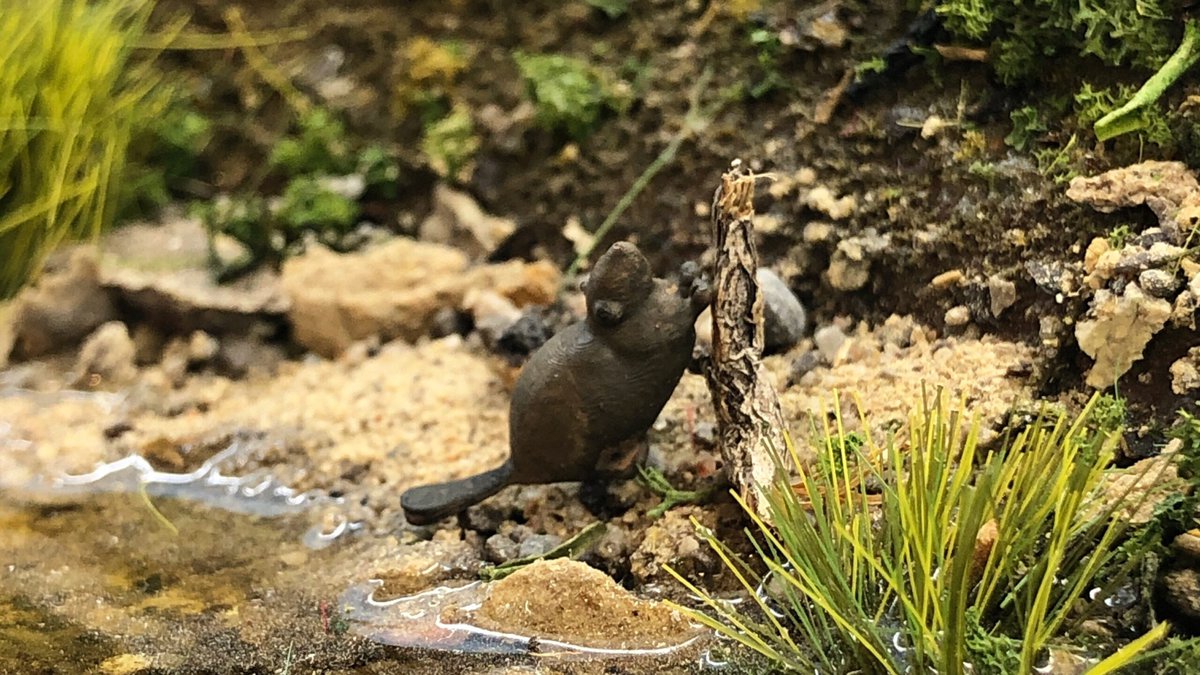
Well, sort of. As I mentioned in my last post, I bought a resin printer. So it was time to put it to work. But what should I make?
As I lamented, 5 years ago, ‘Why doesn’t anyone make a HO scale beaver?’
I found moose, deer, bears, even wolves, but no beavers. The beaver is iconic. A Canadian symbol. The beaver (and it’s pelt) lured the explorers to this land. Hell, the beaver is so important it’s even on the shield of the Canadian Pacific Railway. So… I made one!
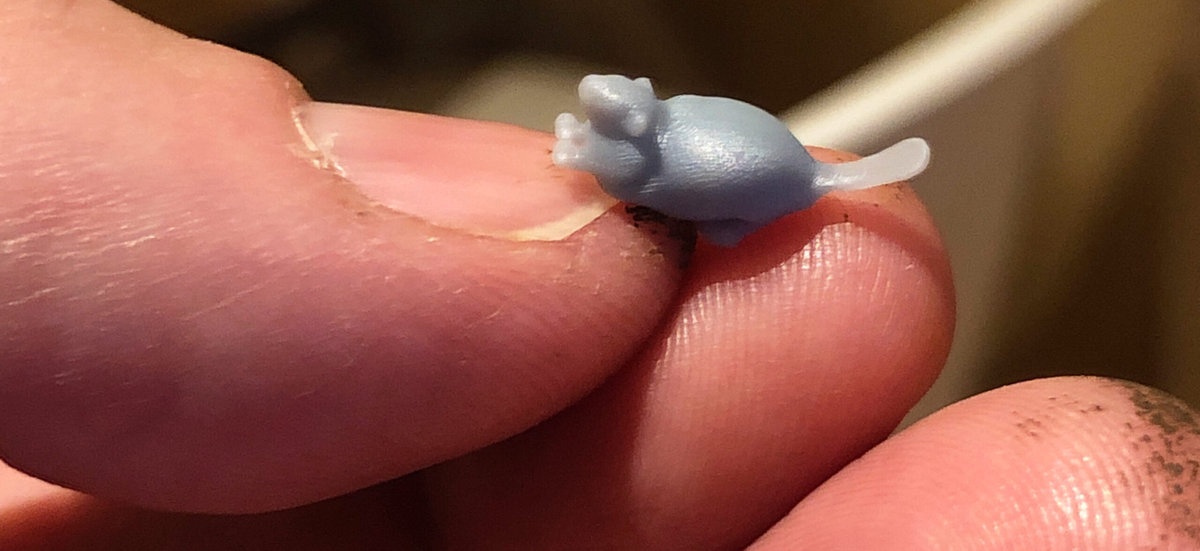
Damn (get it? beaver puns) these things are small.
I posted my creations to the Facebook group Canadian Railway Modellers and suddenly started getting requests, so NOW AVAILABLE to you (from me), HO scale beavers. I’m offering 8 beavers in 3 poses (see below):
3 x sitting
3 x standing up
2 x swimming
for $20 (postage included) to any Canadian address, and $25 US to any US address.
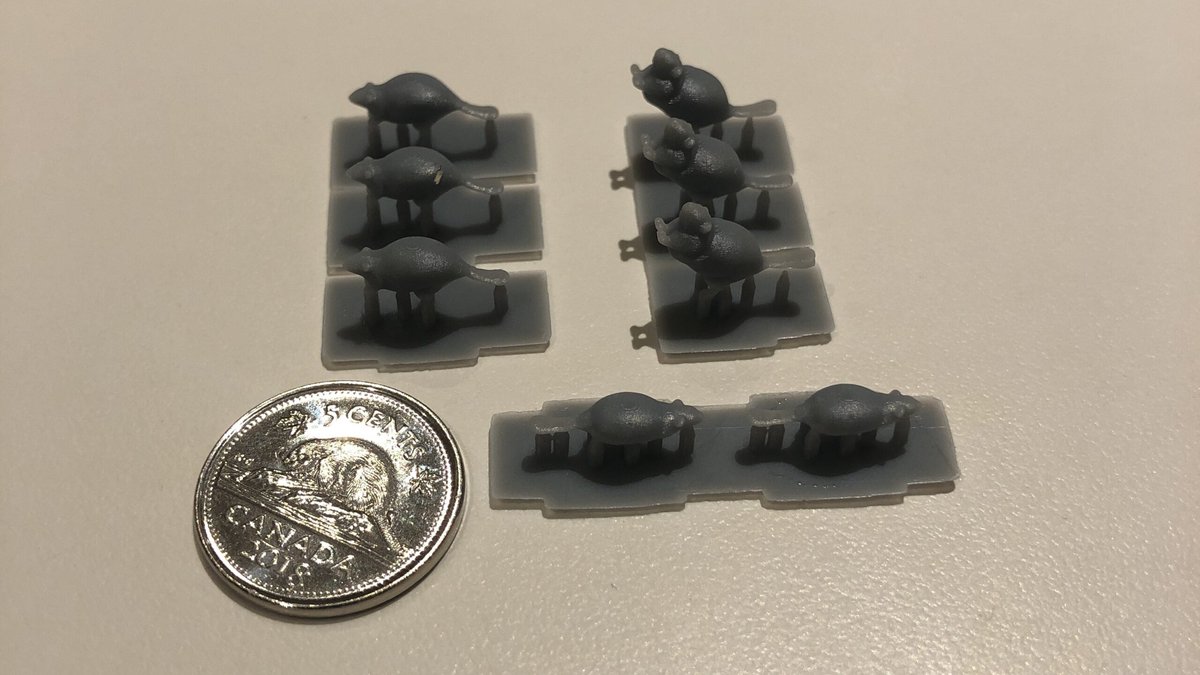
The full set of 8 in all its glory.
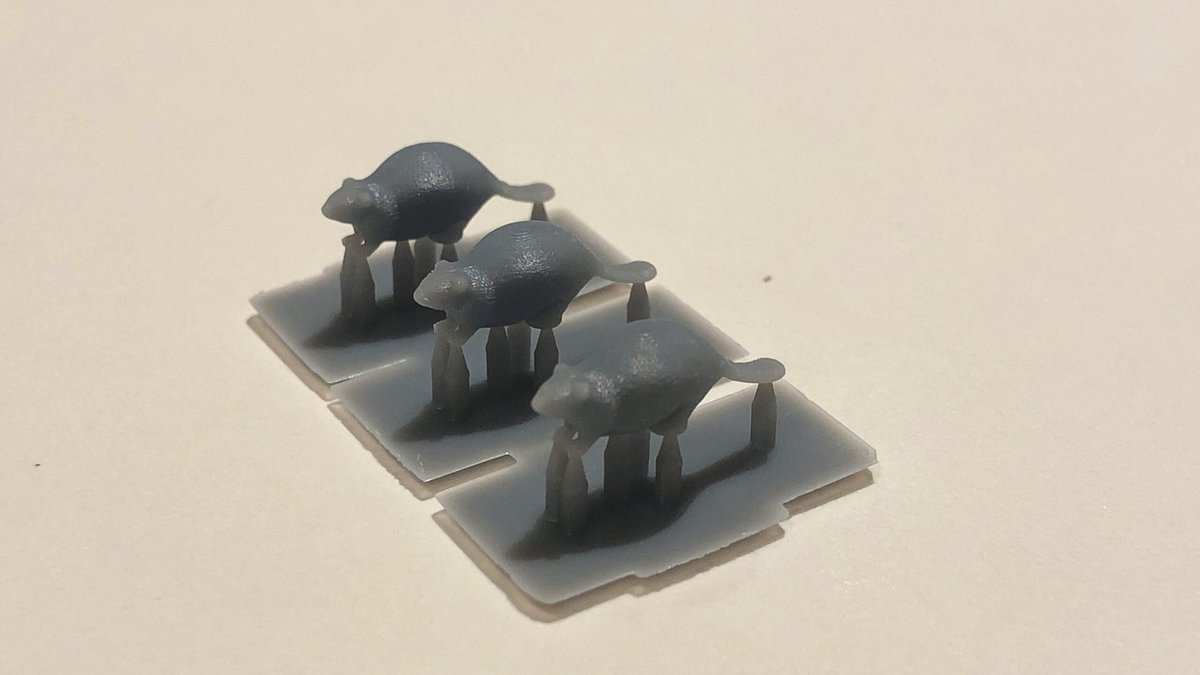
Three (out)standing beavers
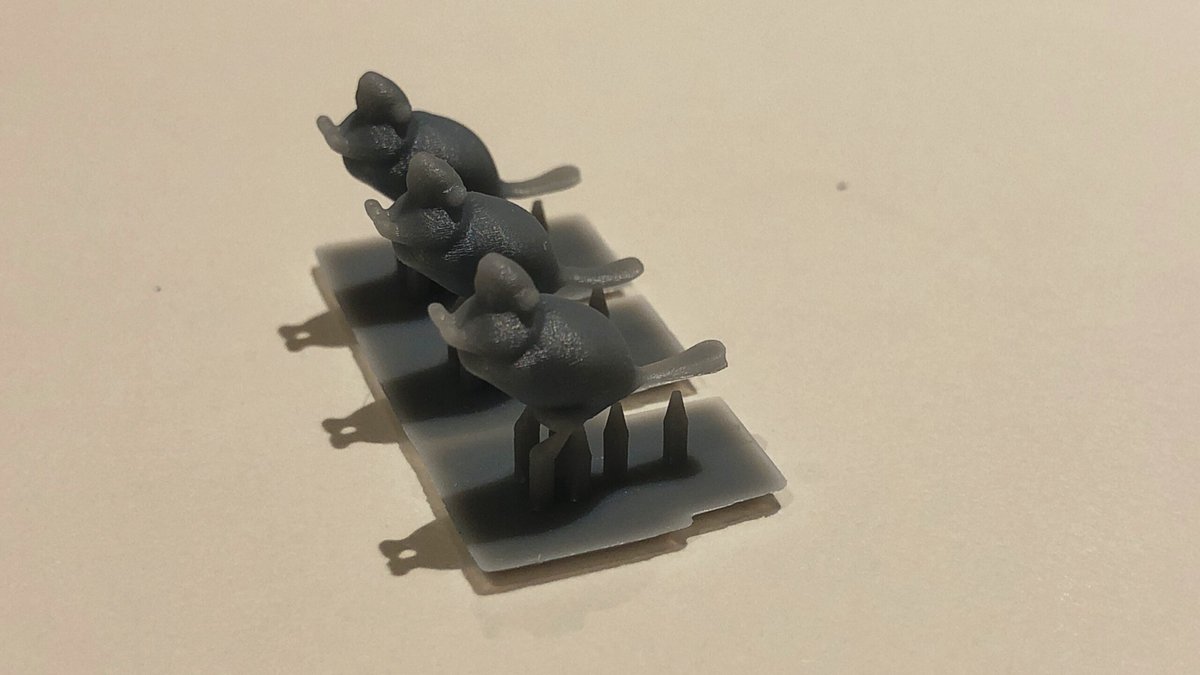
Three sitting beavers (ready to gnaw wood).
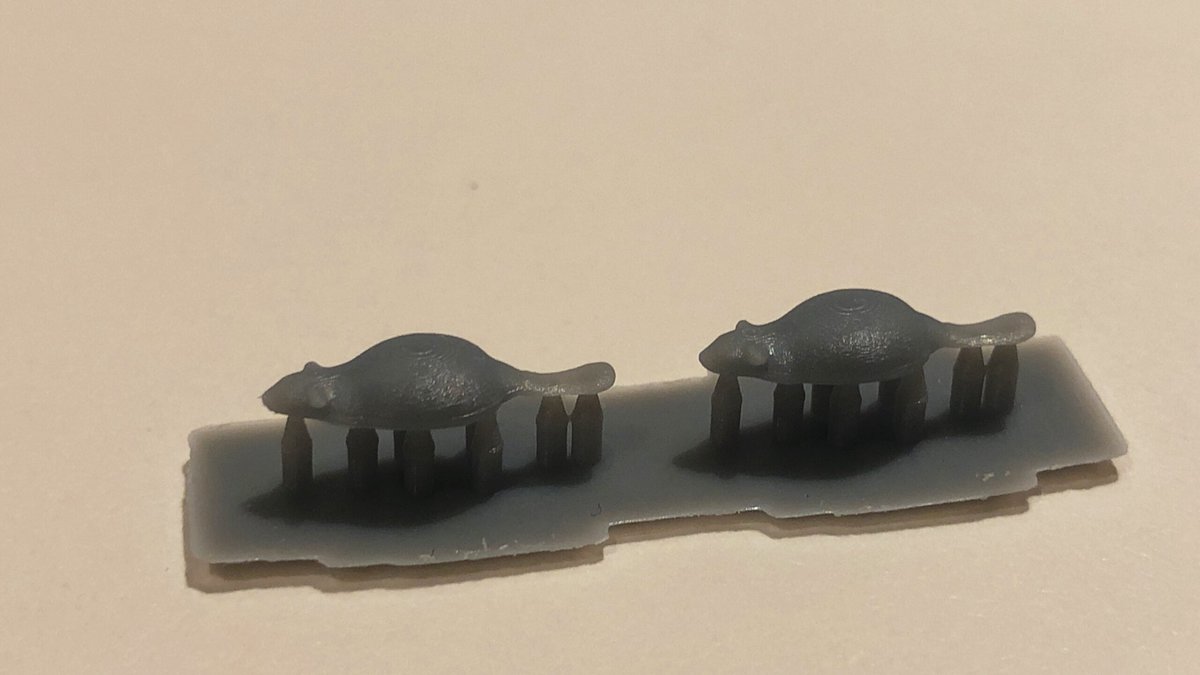
..and…two swimmers.
They look great painted up and satisfaction is guaranteed!
So if you’re looking for a little Canadian beaver (groan), email me at bernard (at) trafficdesign.ca and I’d me happy to make you a set.
P.S. Due to a few requests, they are coming soon in O scale.
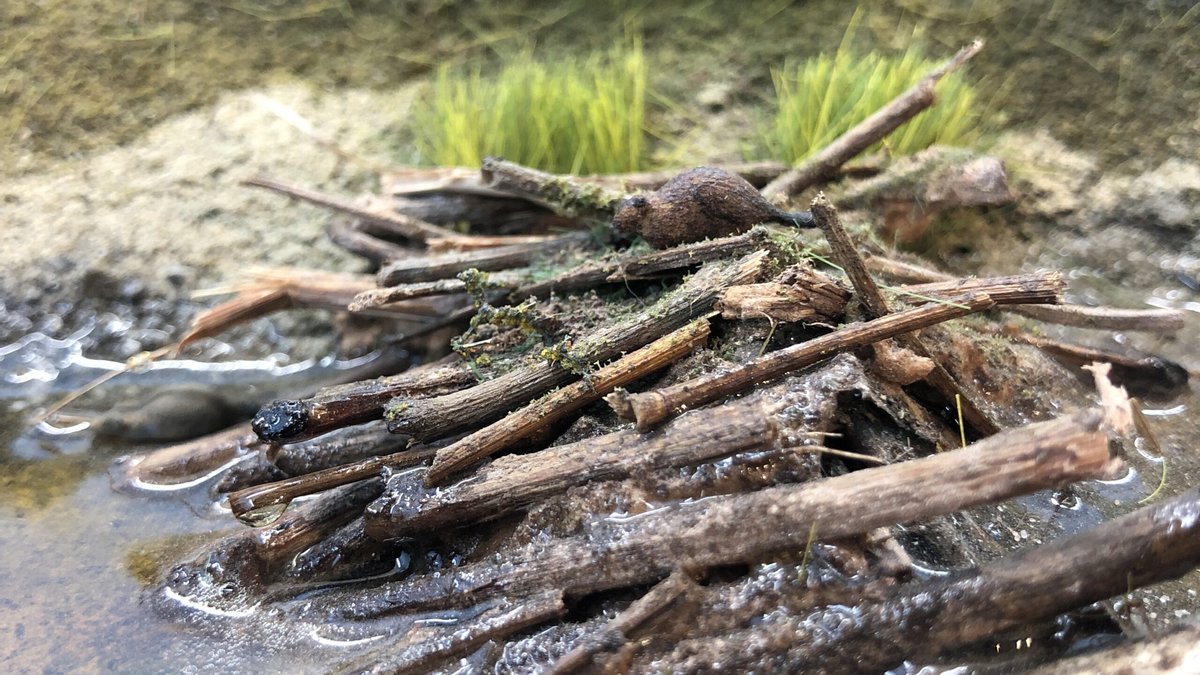
I’m a Martian

I joined a Facebook group called 3D Printing for Model Trains and started to see what inexpensive resin printers were capable of. Blew my mind….

Photo from a Facebook post by Kurt Bainum.
Some of you may remember my past foray into 3D when I printed up some scale beavers.
What really got me was a post by Kurt Bainum where he showed the level of detail he was getting printing in HO scale. Then I stared watching YouTube videos and as they say, the rest was history.

Well I was hooked. So, I finally broke down and bought a 3D printer. I picked up a Elegoo Mars UV Photocuring LCD 3D Printer. There is A LOT to learn but happily a large community of owners called (yup) ‘Martians’ who I hope to learn from.
I’ve already got my eye on some nice models over at thingverse and tinkercad and now all I need is a bit of time to head downstairs and see what I can create.
My fallen flag?

Prototype modelling in Quebec City in 2013. I prefer a 1:1 scale railroad.

Rolland Paper Mill in 1957. That’s a lot of boxcars!

Memories of the 70s.


As you can see, it’s pretty easy to accumulate an all orange and black roster.


Sure wish I still had this loco in the display cabinet.
Will the QGRY revert back to CP colours and become a ‘fallen flag’?
Model Local in 2020

Eric Gagnon in his excellent Trackside Treasure blog suggested that 2020 was the year to Model & Railfan Local. He suggested that we do ‘a moustache’ and look at what’s right under our noses. That got me thinking for a couple of reasons.
I run a company that encourages people to shop local and believe that there is an argument that we should be increasingly thoughtful about the impact that our shopping has on local businesses and communities. Local is the new thing and more people are thinking more about their neighbourhoods.
I also live in west end Toronto and just 500m from my house is a former industrial area off the CPR/CN (now Metrolinx) rail lines. Most of the old warehouses and factories are long gone or have been recently converted into wildly expensive hard lofts. But some traces of the neighbourhoods colourful railroad past still remain.

Time to go exploring.
As one of my favourite parts of this hobby is research, I decided to fire up the google machine and check the archives. And then I went for a walk in the ‘hood.

The 1958 City of Toronto Planning Board Atlas is a ‘to scale’ wealth of information of what was.
Sorauren Avenue
1. 239-251 Sorauren Avenue
J.M. Loose & Sons Ltd. (piano keys & actions)
and replaced by Lester & Burton Ltd.
In 1951 they were listed as a woollen mill with over 50 hands.
Here is a first hand account of one of their employees:
https://miriamprl.blog/2015/11/13/finding-a-place-to-call-home/
2. 263-269 Sorauren Avenue
Lowe Brothers Co. Ltd.
This paint and varnish company had between 100-199 hands in 1951. It had a siding on the north side of the building on Wabash Avenue. The building was demolished in the late 1970s and has been replaced by the Charles G. Williams Park.

Wabash Avenue
3. National Equipment Co. Ltd. 1 Wabash Ave.
Canadian Carbonate Ltd. (carbonic acid gas) 5 Wabash Ave.
WABASH AVENUE TEAM TRACK
Eastern Power Devices Ltd., 29 Wabash Ave., Toronto 3. (200-500 employees)
All these businesses are long gone and the buildings have been demolished and replaced with town homes.
4. 40 Wabash Avenue
Canada Linseed Oil Mills Ltd.

The Canada Linseed Oil Mills property on Wabash Avenue, looking north with the Grand Trunk railway (now Metrolinx GO line) behind it. The grain elevators are now gone.
This is the building that really grabs the imagination and is probably one of the best least disturbed industrial relics in the neighbourhood. It was built in 1915 and has been abandoned since 1969. It will live again and is being repurposed into the $40 million Wabash Toronto Community Centre.

The Canada Linseed Oil Mills buildings have been standing on Wabash Avenue for nearly one hundred years. For forty of these years, they have been vacant. Industry’s gradual exodus from the surrounding area has been steady; several nearby buildings which once employed local residents and made products for the community have been retrofitted and reborn as condos or artist’s studios, while other buildings have been torn down completely and placed with new city infrastructure. The Canada Linseed Oil Mills structures have yet to undergo this rebirth, but they have certainly not been forgotten.
Shortly after the turn of the 20th Century, a manufacturing area grew along Sorauren Avenue, just south of Dundas Street. Industry was spurred all along the Canadian Pacific Railway lines lying to the immediate east, which over the years belonged to several railroads including the Credit Valley Railway and the Toronto, Grey and Bruce. The strip along Sorauren was also just south of a major rail junction, near where Annette, Dundas & Dupont streets all come together. From this lucrative location at the northern tip of Parkdale, an industry could easily connect by rail with all of southern Ontario.
from http://spacing.ca/toronto/2010/04/09/building-storeys-the-canada-linseed-oil-mills-buildings-sorauren-park/

Canada Linseed Oil Mills (back left of photo) and Lowe Bros. Paint (front, right) on Wabash Avenue. Check out the team track in the middle of the street!
Sorauren Avenue
5. 345 Sorauren Avenue and 347 Sorauren Avenue
Neptune Meter Co. Ltd. (water meters) (Still Standing)
Line & Cable Accessories Ltd., 1951 (over 50 employees)
Corman Engineering Co.Ltd. (cyl. grinders)
Jack Frost Ice Machine Co.Ltd.
Chapman Double Ball Bearing Co.of Can.Ltd.

An old ball bearing factory from sometime around the turn of the century, 347 Sorauren is actually a composite of the initial mill style warehouse with two new additions, featuring a combination of interesting industrial finishes. It is now a loft conversion that features 15 foot ceilings with massive timber columns and beams. Vintage meets contemporary at the 48-unit Sorauren Lofts building, with dramatically high metal ceilings with open web steel joists and 6-foot windows. https://www.sg.jeffreyteam.com/sorauren-lofts-347-sorauren-avenue/
6. 361 Sorauren Avenue
643 Channell Ltd.(“O’Cedar” furniture polish)
647 Canadian Sunbeam Lamp Co.Ltd./ 647 Cannon Canadian Co. Ltd.(adhesives,glue)
7. 363 Sorauren Avenue
Robert Watson Co.
This is the biggest industrial building left. The factory was built in 1907 and there were additions made in the 1920s. The company was known for their “Watson’s Cough Drops”. Their slogan was “Koff No More” and they marketed them towards smokers who had sore throats. At some point they switched from cough drops to mints.

Great article with more info can be found at https://www.sg.jeffreyteam.com/robert-watson-lofts-363-369-sorauren-avenue/
8. 383 Sorauren Avenue – Doan Coal Co. Ltd. (gone – new condo development)
9. 393 Sorauren Avenue – Wilkinson Foundry Facing & Supply Co.Ltd.

An aerial view of Sorauren and Wabash Avenues circa 1959.
I plan to do a lot more exploring in the neighbourhood and who knows, maybe the next layout will be an industrial Toronto switching layout set in the 1950s!
Super-detailing a Walthers Plastic Kit
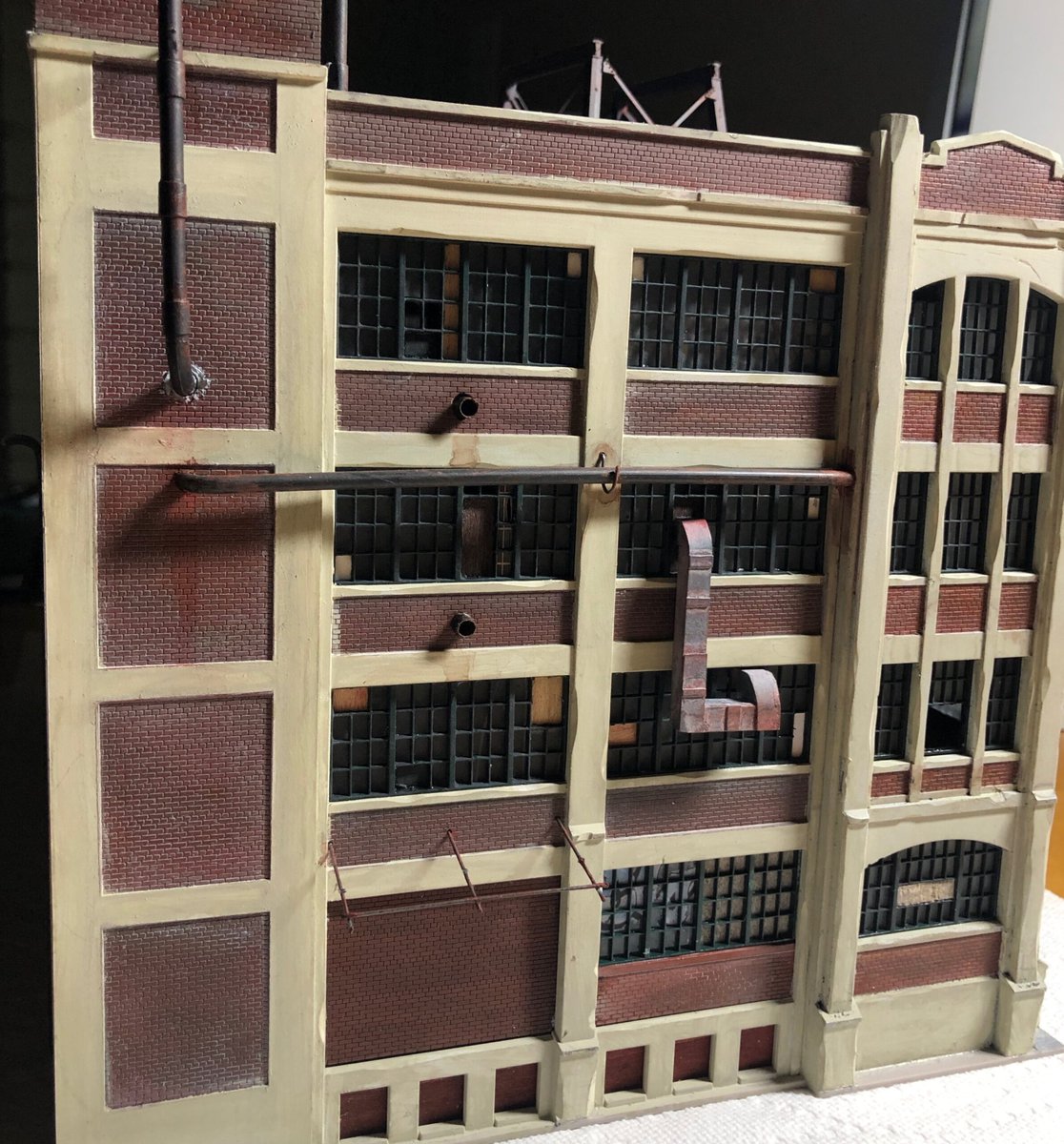
My project for the holiday break was to build a Walters plastic kit as a movie prop that my film-student son wanted to use for a stop-action animation project. I figured this was a good chance to practise a few techniques.
I had picked up a Walthers American Hardware Supply kit (below) for cheap at a show a couple of years ago and wasn’t planning on using it for the layout, so this was pretty low risk. I figured that if I ruined it, no biggie.
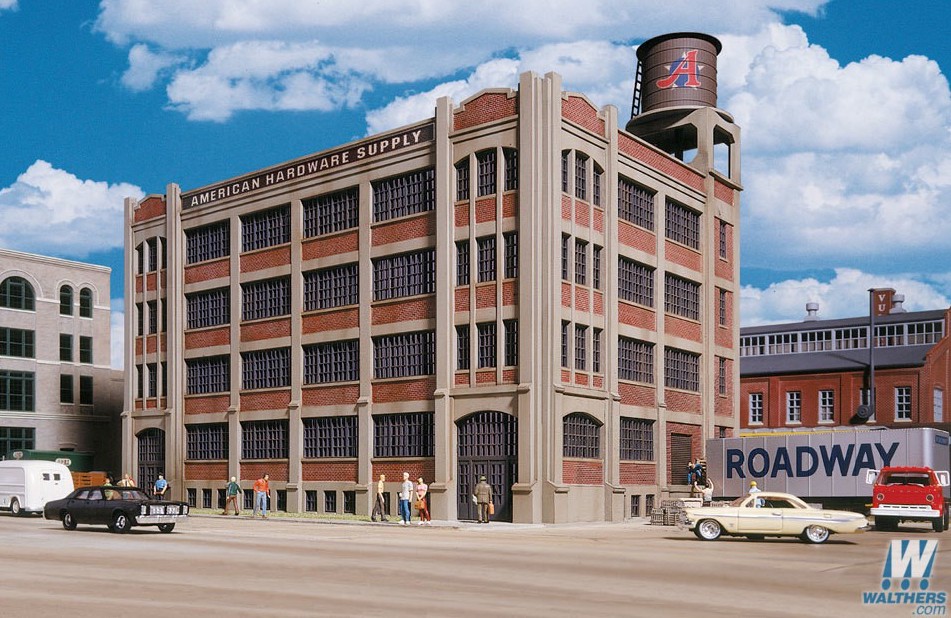
The challenge that I set myself was the following: Could I build the kit as per the instructions, however using all of my (limited) painting and weathering skills, make it look more like a craftsman kit?
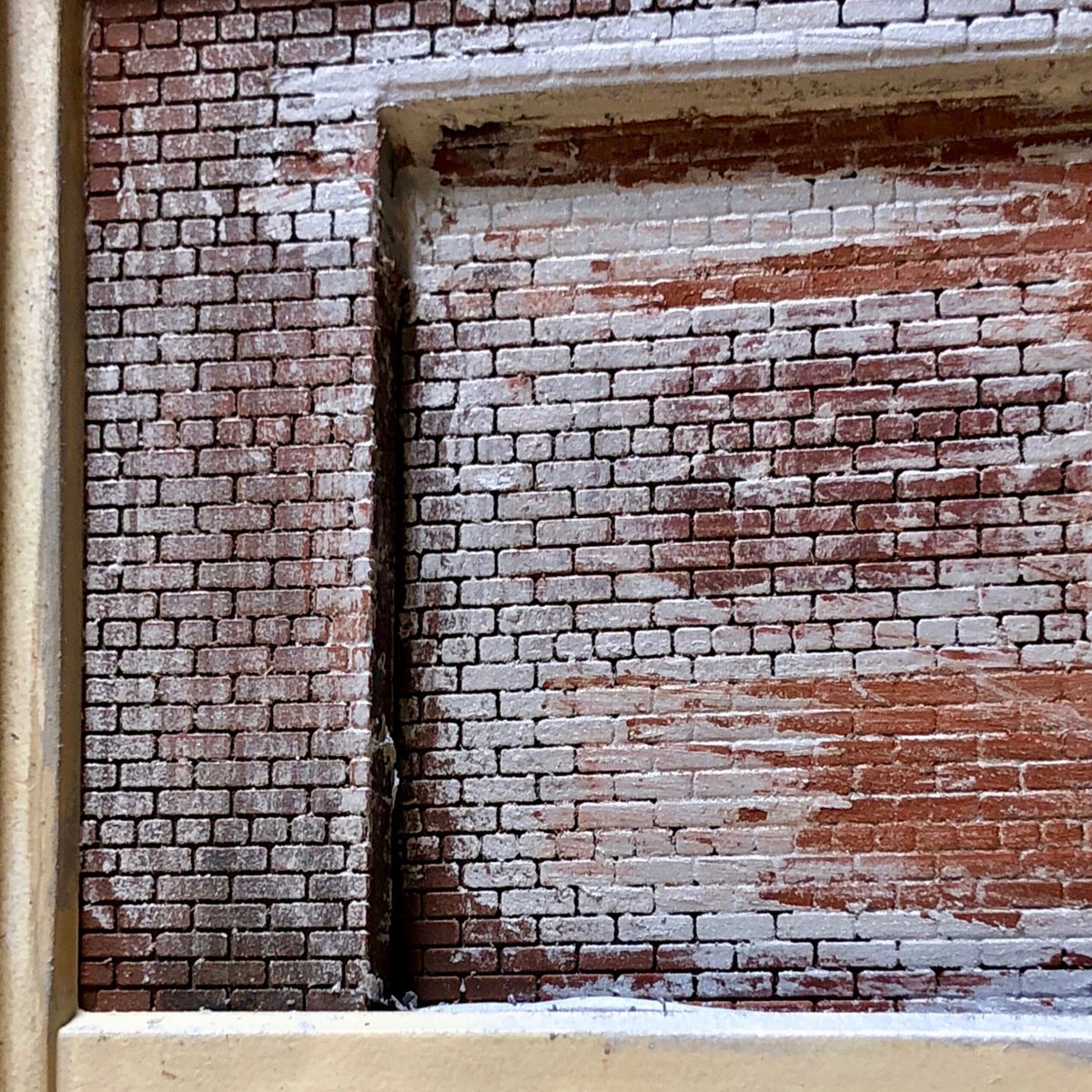
In short, the design brief was to elevate the blah plastic kit and make it look decent. Here are a few thoughts and some of what I learned:
1. Observe the real world and work from photographs. Things don’t always look the way that you think they do. For example, tree bark isn’t brown, its grey. Concrete isn’t grey, it more of a taupe. And don’t get me started on bricks – WOW, just wow.I find that a lot of models look very uniform when in reality things are so incredibly random. I knew that I wanted this building to look really run-down and past it’s prime so I did a quick Google image internet search for “abandoned warehouse brick wall” and really tried to study the complexities of the real world.
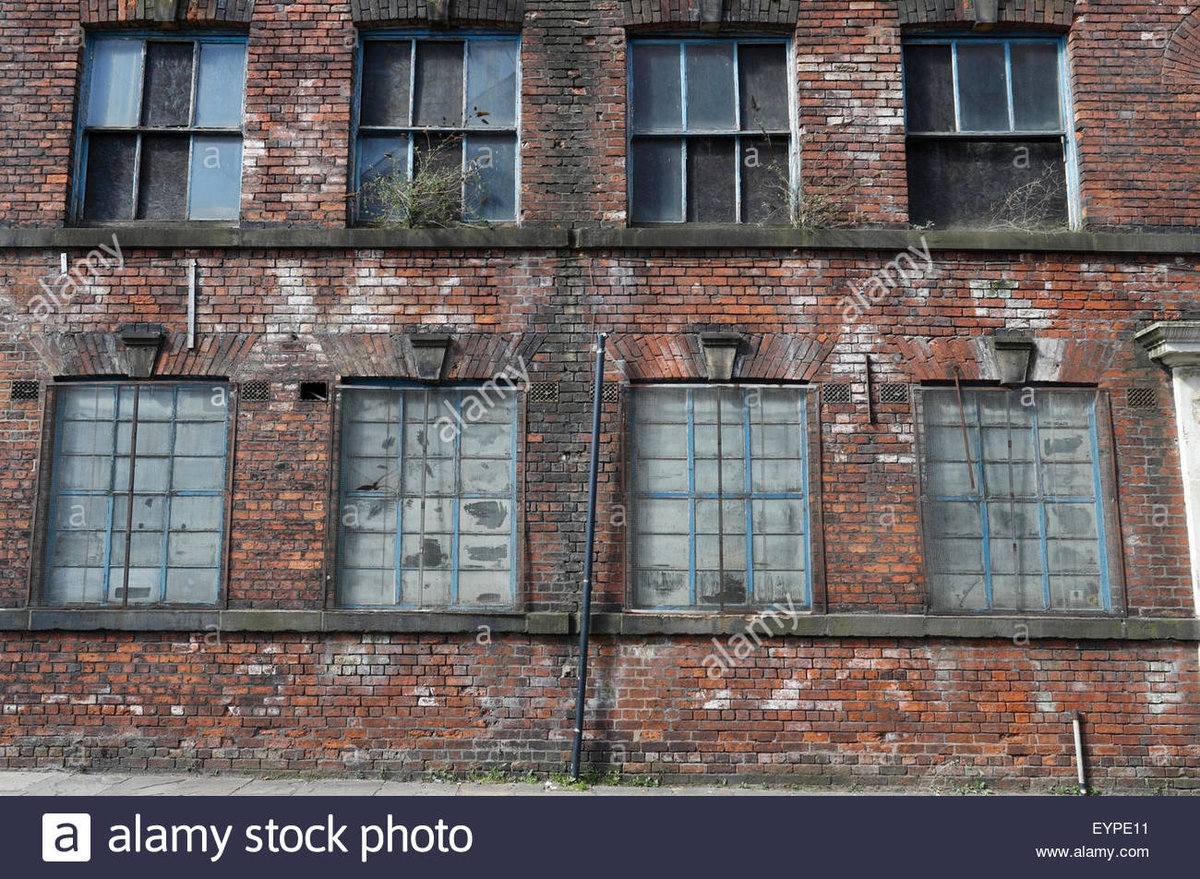
2. Don’t be afraid to chop, cut, break and destroy. Reality is imperfect and so should your model. Rough it up. I really tried to shave down the rough edges (see pic below). Clean, crisp plastic with perfect right angles – no thank you.
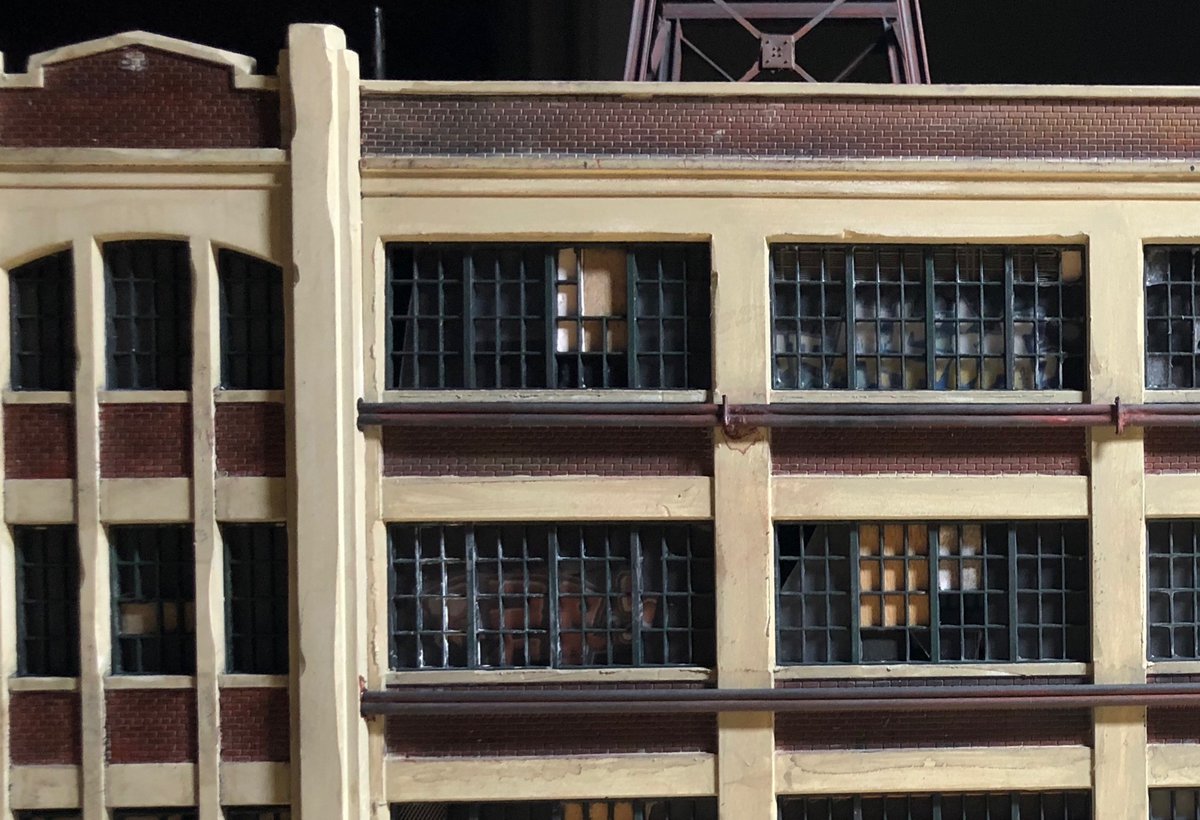
3. Play. Try. Fail and fail again. Get creative. Not everything will work but its usually worth trying a few new ideas to see which will give you the result that you are most happy with. There are usually many ways to achieve a specific look. For the windows I tried breaking plastic, used opaque scotch magic tape, a variety of clear glues, etc. I also used, paper, wood, screen…anything that might look interesting.
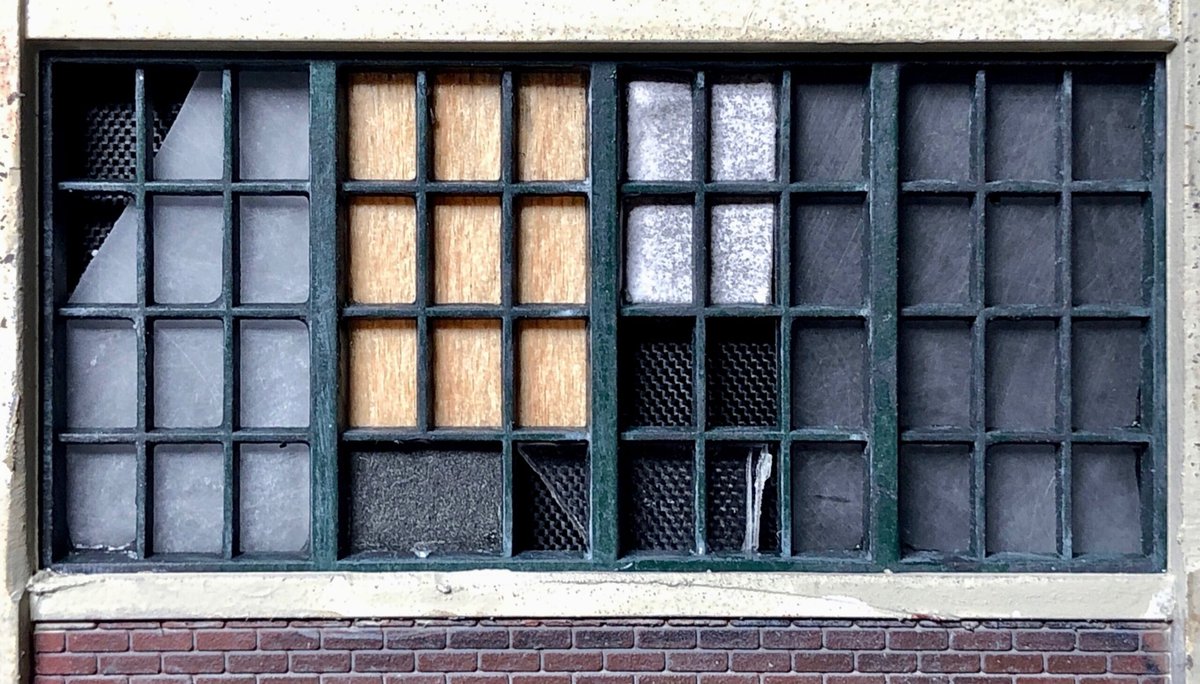
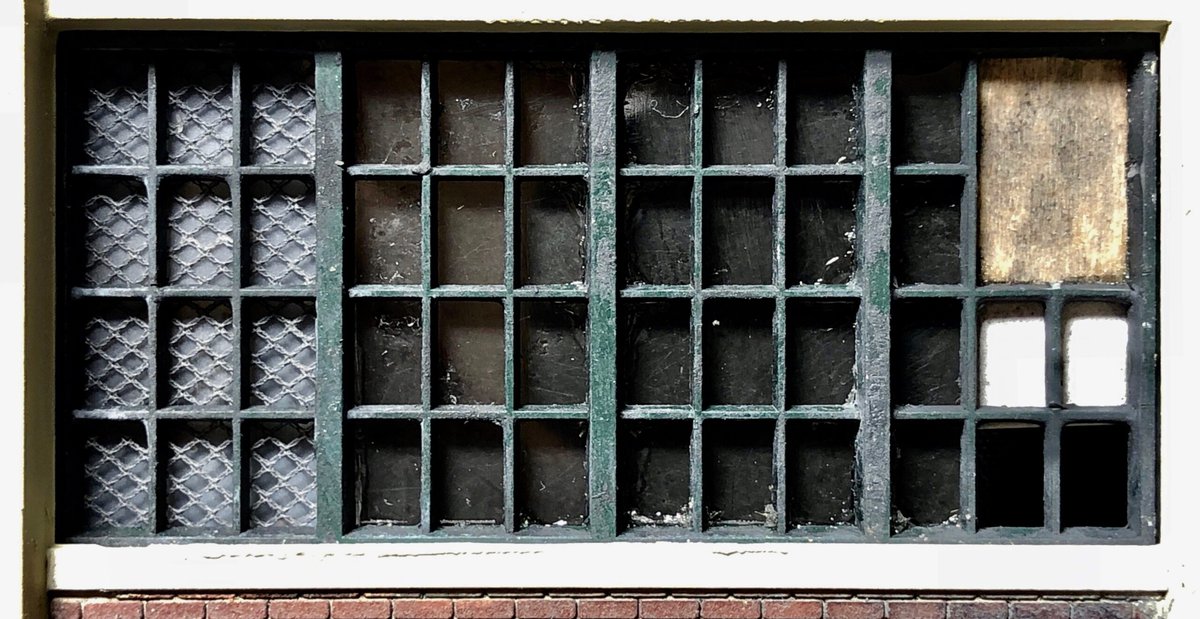
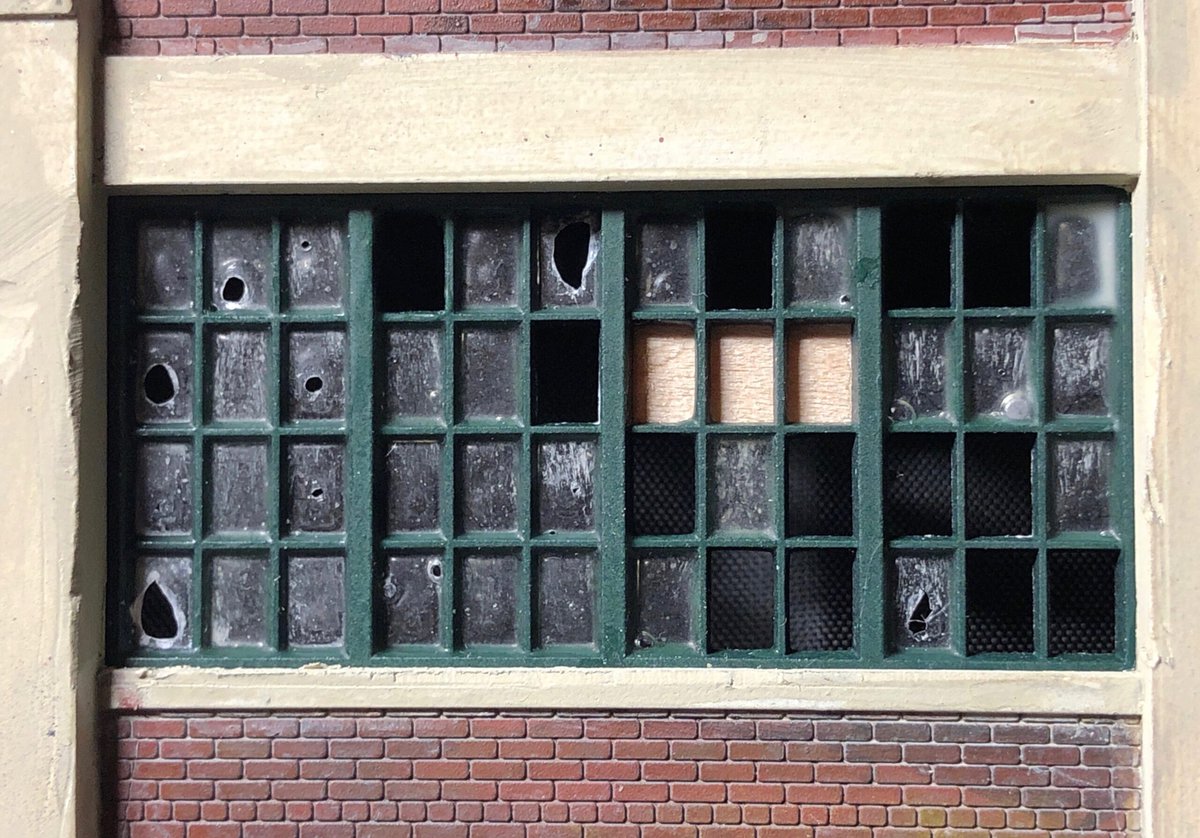
4. There are happy mistakes. (Otherwise known as, “I meant to do that”). I find that when it comes to weathering that less is MORE. But if you do overdo something – it can usually be ‘fixed’.
5. Paint everything BEFORE assembly and mask, mask mask and mask again. I’m a big fan of using rattle can spray paint as a base coat for the plastic pieces. Krylon ColorMaster Primer Oxide Red Ultra Flat is my goto for a base coat of brick and the Satin Ivory works well as a base for concrete. I’ll use acrylics applied usually by brush on top of the spray paint. Occasionally I’ll pull out the airbrush if I have to, but as I am without a spray booth at the moment, I try to avoid airbrushing. Good prep work at the pre-assembly stage while time consuming, does pay off with a much better looking model in the end.
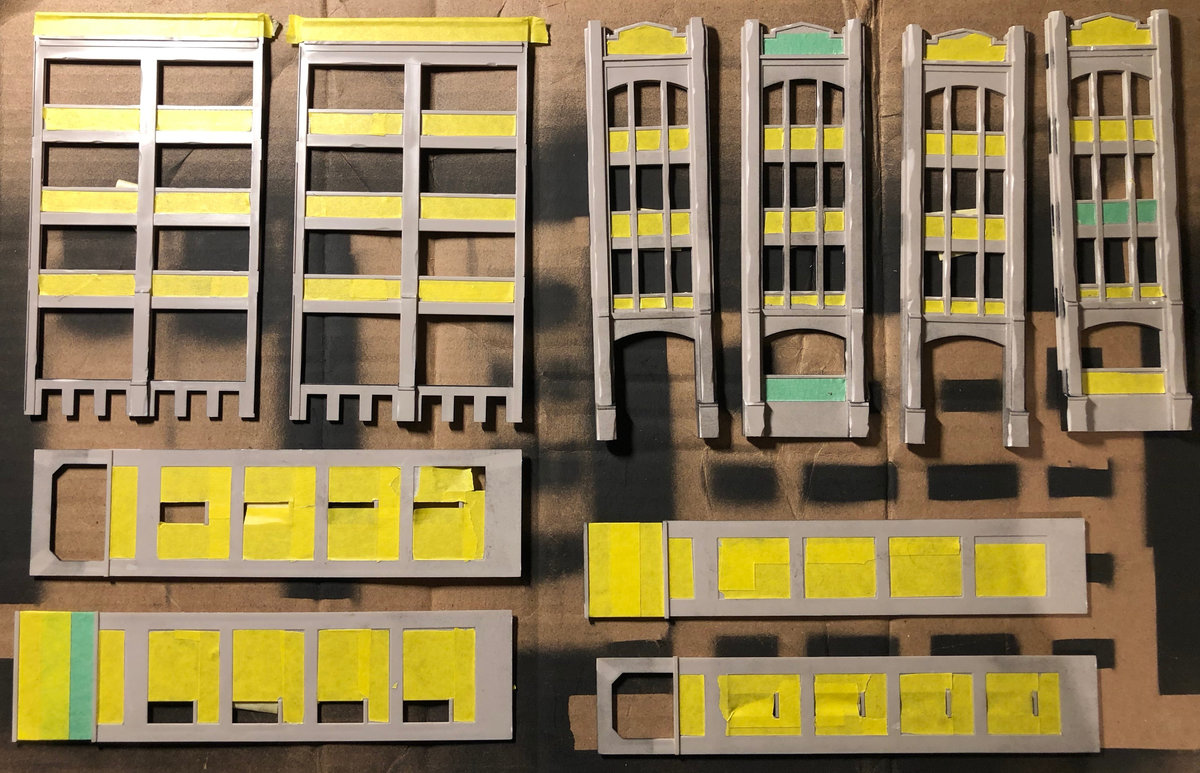
6. Add little details that are not part of the stock model. I call this ‘going down the rabbit hole’ as you can really get lost in the detail work. This for me is the fun part as it is the most creative. The photo research from prototypes can yield literally hundreds of little details than can be incorporated into your model to achieve that added realism. For example, I love all the piping that is found on factories and I have tried to incorporate this into my model.

7. WEAR disposable nitrile gloves. Seriously, its amazing how much better the model looks when you do not have fingerprints and glue smudges. Not to mention, that I have reduced the number of times that I Krazy glue my fingers together. I buy the 300 pack from Costco.ca for $20.

8. Alcohol and india ink is your friend. I ‘weather’ everything with a 70% isopropyl alcohol/india ink mix. It dulls down the freshly painted look and a few light washes added over time work better. Dullcoat also is an essential ‘tool’ to knock everything down.
9. Adhesives. LOVE them and always have a bunch on hand. My three top picks are canopy glue, Krazy Glue CA and Tamiya 87038 Extra Thin Cement.
10. Take a photograph of your work. Look at the photo and critique the photo and not the model. It’s amazing what your eyes miss looking at a ‘real’ model and can catch by looking at a photo. Or put another way, our eyes lie to us. Having read a little about this (may be a future blog post) all I can figure out is that what our eyes see isn’t really real, it is what our brain has created. Perhaps our brain process a flat 2D image differently than a 3D item?
And here is a BONUS lesson learned:
11. You are NEVER finished. But sometimes you need to just STOP.










Recent Comments